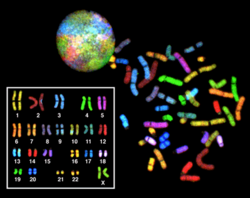Eukaryotic Chromosomes
(Redirected from Chromosomes)
The eukaryotic chromosomes are more complicated than procaryotic. They encode more information (coding and non-coding parts) so we recognize bigger count of chromosomes in Eukaryota. Their count depends on the evolution of the species. But they structure is pretty similar.
DNA contains milions and milions of nucleotides and it is neccesary to compress them. In eukyryotic chromosomes we recognize a process similar to supercoiling in Prokaryota. This is made possible by special proteins – histones - which packed the DNA strand. Complex of DNA and these proteins is called chromatin.
DNA is turning around the histones. Sometimes it is said that it looks like the beads on a string. This is a principle, which allows to get so long DNA strand (human DNA has more than 2 metres) into the cell and chromosomes.
Structure of Chromosomes[edit | edit source]
We recognize few parts of chromosomes. But it is neccesary to said, that the shape of the chromosomes is changing during the cell division. The classic shape which is well–know is typical just for the short part of the division – for mitosis, especially its metaphase. In this phase the chromosomes are the most compact. During the interphase they are pretty hackney and they look like very long and thin fiber.
Compact chromosome has 3 main parts. Centromere and two arms:
Centromere[edit | edit source]
- is a middle part that connect both arms together. It is very important also during cell division because it is the place where kinetochor is binding. It is a very important complex which binds a mitotic spindle. All of this serve to the separation of chromosomes.
Short and long arms[edit | edit source]
- short arm of the chromosome is also marked by letter (p), according to French "petit" (means small)
- long arm of the chromosome is marked by (q) – according to the letter which follow (p)
- the terminal parts of arms have their own name – they are called telomeres
Sorting of Chromosomes[edit | edit source]
Chromosomes are normally colorless but we are able to dye them (Giemsa dye). Then we get the picture of stripted chromosomes. Why? The dye binds more to parts which are rich of adenin (A) and thymine (T) bases. This should be very usefull for scientists who are looking for some chromosomal abnormalities. The shift of some segments is connected with the change of banding.
We should recognize individual chromosome also in another way - with the fluorescent colors. We should choose a different color for specific parts of the chromosome. Then each pair of homologous chromosome is getting different color. Then it is very easy to sort them.
Links[edit | edit source]
Related articles[edit | edit source]
Bibliography[edit | edit source]
- ALBERTS,, et al. Základy buněčné biologie. 2.vydání edition. 1998. ISBN 80-902906-2-0.






